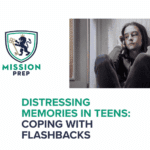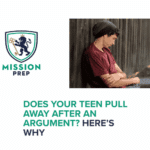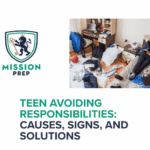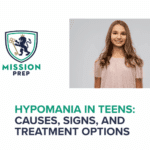Teen Hypervigilance: Causes, Symptoms, and Coping Strategies

Threatening situations can occur in our day-to-day lives, so it’s often necessary to know how to handle them effectively. Being aware of our surroundings and preparing ourselves for danger is a natural instinct, and it isn’t necessarily a bad quality in moderation.
However, when someone is constantly on the lookout for threats to their well-being, spending excessive amounts of time preparing themselves for their appearance, this is known as hypervigilance.
Hypervigilance can get in the way of everyday functioning, affecting teens’ academic performance, relationships, sleep, social withdrawal, as well as emotional and physical health. Understanding how and why hypervigilance occurs is often the first step to getting a teen the help they need – a mental health professional can guide you in this process.
This article can also help you better understand teen hypervigilance, as it explores:
- What teen hypervigilance is
- Potential causes of teen hypervigilance
- Symptoms of teen hypervigilance
- Treatment options for hypervigilance in adolescents
- The role of parent support in helping hypervigilant teens cope
- Where to find professional support

What Is Teen Hypervigilance?
Clearly, teen hypervigilance can be displayed in different ways. These include, but aren’t limited to, seeking out threatening situations or focusing on situations that have already proven not to be a threat. Additionally, a teen may have heightened awareness of both threatening and unthreatening stimuli.1
Hypervigilance is often a symptom of an underlying mental health condition. For example, teen hypervigilance is closely tied to anxiety disorders and other mental health concerns, such as depression. As such conditions can worsen without treatment, they should, therefore, be taken seriously and addressed in a timely manner.
Causes of Hypervigilance in Adolescents
Some of these factors are related to genetics and heritability, while others are based on a teen’s development and cognitive processing abilities.2 The following sections take a closer look at some of these factors.
Genetic Predispositions
Mental health conditions like anxiety disorders tend to be highly heritable. In fact, children of parents diagnosed with anxiety disorders have higher rates of developing anxiety in their lifetime compared to the average teen. However, just because a relative has anxiety doesn’t mean a teen is guaranteed to develop it – it might just be good to acknowledge that this is a risk factor.2,3
Parenting Styles
Different parenting styles are linked to higher rates of anxiety in teens.2 When there are constant arguments and conflicts in the home, adolescents may be more vulnerable to developing hypervigilance as a way of coping with volatility.
In addition, when parents exhibit anxious behaviors, this could predispose children to anxiety disorders. In other words, while there is likely no malintent involved, parents may inadvertently reinforce hypervigilance by modeling anxiety behaviors in the home.2
Exposure to Traumatic Events
Trauma can occur in many forms. For example, natural disasters like earthquakes, fires, and hurricanes could trigger hypervigilance in teens. Likewise, emotionally traumatic events like abuse or losing a loved one can cause a teenager to become increasingly anxious due to the desire to avoid further hurt or loss.2 In fact, hypervigilance is one of the core PTSD symptoms in teens that can lead to a psychiatric diagnosis.
However, trauma can be subjective, so it may be important to consider a teen’s individual reaction to an event.
Physiological and Biological Factors
There are a variety of complex biological factors that may relate to anxiety in teens, leading to extensive research. For example, dysfunction of the stress response system is associated with the development of anxiety disorders.3 In addition, adolescents with higher heart rates and blood pressure have increased rates of anxiety. Another biological risk factor for developing an anxiety disorder is obesity.
It’s important to note that these biological factors are still being studied. Therefore, just because a teen falls into one of these categories doesn’t mean they’re guaranteed to develop anxiety and hypervigilance.
Comorbid Mental Health Problems
If an adolescent suffers from other mental health issues, they may be more likely to also be diagnosed with an anxiety disorder.2 These issues can include depression, attention-deficit hyperactivity disorder (ADHD), eating disorders, or oppositional defiant disorder. Early detection and diagnosis of any mental health concern for teens is crucial to get them on the right path for treatment.
Symptoms of Teen Hypervigilance
Further, a child who tends to get good grades might display hypervigilant behavior by constantly worrying about performing poorly on a test. Even though they might know the material and they’ve proven that the situation isn’t threatening, they continue to react maladaptively.1
Likewise, less flexible thinking, or focusing solely on worries and ruminating on obsessive thoughts, is a common sign that a teen is suffering from hypervigilance and anxiety.1 For instance, you might notice your teen voicing the same worries repeatedly at home, and no amount of encouragement seems to assuage their fear. They might also startle easily or feel on edge in a safe environment.
Recognizing these symptoms is important because they can be easily missed if your teen is still functioning at an appropriate level. Despite high levels of anxiety, teens can mask their symptoms through high achievement and productivity. Therefore, noticing small changes and how they impact your teen on a daily basis can make a real difference to their long-term well-being.
Treatment Options for Hypervigilance in Adolescents
The following are some approaches commonly used to treat hypervigilance in teens.
Coping Strategies for Anxious Teens
Developing strong coping strategies is one way for teens to combat hypervigilance and anxiety. For example, learning to reframe negative thoughts and worries can be an effective coping strategy that teens can implement on their own or with the help of a therapist. Reframing thoughts involves a teen recognizing worries when they pop up and identifying what is in their control vs. what is out of their control. After this, they can work toward changing any misinterpretations of an event by focusing on objective facts.4
Learning how to regulate emotions is also an important skill for managing anxiety and hypervigilance. There are many emotion regulation strategies that teens can implement on their own or in a therapeutic setting. A few examples include practicing problem-solving skills, identifying emotions before they become overwhelming, and reducing physical vulnerability factors by getting adequate sleep and eating a healthy diet.5
Therapy for Hypervigilance
In some situations, a more structured approach, such as psychotherapy, is necessary to treat teen hypervigilance. Two forms of therapy that have been shown to be effective in treating anxiety are cognitive behavioral therapy (CBT) and dialectical behavior therapy (DBT).5,6 We discuss these approaches in more detail below.
CBT for Anxiety in Teens
CBT focuses on individual therapy sessions for teens where they can talk through difficult emotions and come up with ways to react more positively in the face of threatening situations. CBT can also include group sessions with peers in a classroom setting or additional parental support for hypervigilant teens. The ultimate goal of CBT in these situations is to develop more effective coping skills for managing hyperarousal in teens.
DBT for Anxiety in Teens
DBT has a structured curriculum including four modules: mindfulness, distress tolerance, emotion regulation, and interpersonal effectiveness. A main focus for treating hypervigilance with DBT is implementing teen mindfulness techniques.5 This can encompass a variety of activities like guided imagery, paced breathing, and progressive muscle relaxation.
In addition to developing mindfulness skills, DBT sessions can also emphasize the importance of emotion regulation skills. One of its skills, PLEASE, is an acronym that helps teens target specific vulnerability factors that can make them more likely to experience anxiety. These are:
Treat PhysicaL illness- Eat balanced meals
- Avoid mood-altering substances
- Get enough Sleep
- Exercise
Medication for Hypervigilance
For cases of severe hypervigilance that cannot be treated with therapy alone, medication may be considered. Some medication options include selective serotonin reuptake inhibitors (SSRIs), atypical antidepressants, and benzodiazepines.7 Of course, there are always risks to psychiatric medications, and working with a qualified mental health practitioner is necessary for medication management.
Clearly, there are a variety of treatment options for teen hypervigilance and anxiety, which can be encouraging for families struggling to cope with the issue in day-to-day life.
Parental Support for Hypervigilant Teens
As mentioned earlier, CBT sometimes incorporates family therapy and parent psychoeducation to encourage more healthy coping skills for a teen.6 Parents can further help teens by modeling positive coping strategies when they are faced with threatening situations, demonstrating the effectiveness of the skills over maladaptive hypervigilant responses.8
Moreover, simply recognizing that they have your support can help a teen feel more secure in their day-to-day life. Your presence can normalize their experiences and become an extra buffer against hypervigilance.

Mission Prep: Helping Teens with Mental Health Struggles
At Mission Prep, we emphasize the importance of mental health awareness in teens. By recognizing the warning signs of hypervigilance and providing early intervention for anxiety disorders, we can help you and your teen feel comfortable seeking the appropriate level of care.
Whether you’re looking for outpatient treatment or more intensive residential or inpatient mental health treatment, Mission Prep offers a variety of options to best meet your needs. Contact us today to learn more about these programs and how your teen can get on the path to anxiety disorder recovery.
References
- Asadi Rajani, M. and Sharifi Daramadi, P. (2024). Response inhibition, cognitive flexibility and hypervigilance in adolescents with and without generalized anxiety disorder. Journal of Research in Psychopathology, 5(16), 1-11. doi: 10.22098/jrp.2023.13194.1184
- Kaur, Achint. (2022). The Roots of Anxiety Disorder in Children and Teenagers; What it is in Detail. International Journal of Engineering and Technical Research. 11. 10.17577/IJERTV11IS040090.
- Narmandakh, A., Roest, A. M., De Jonge, P., & Oldehinkel, A. J. (2020). Psychosocial and biological risk factors of anxiety disorders in adolescents: a TRAILS report. European Child & Adolescent Psychiatry, 30(12), 1969–1982. https://doi.org/10.1007/s00787-020-01669-3
- Orson, C. N., & Larson, R. W. (2020). Helping teens overcome anxiety episodes in project Work: The Power of Reframing. Journal of Adolescent Research, 36(2), 127–153. https://doi.org/10.1177/0743558420913480
- Pedrini, L., Rossi, R., Magni, L. R., Lanfredi, M., Meloni, S., Ferrari, C., Macis, A., Lopizzo, N., Zonca, V., & Cattaneo, A. (2021). Emotional Regulation in Teens and Improvement of Constructive Skills (EmoTIConS): study protocol for a randomized controlled trial. Trials, 22(1). https://doi.org/10.1186/s13063-021-05886-2
- Baker, H. J., Lawrence, P. J., Karalus, J., Creswell, C., & Waite, P. (2021). The Effectiveness of Psychological therapies for anxiety Disorders in Adolescents: A Meta-Analysis. Clinical Child and Family Psychology Review, 24(4), 765–782. https://doi.org/10.1007/s10567-021-00364-2
- Silverman, W. K., & Field, A. P. (2011). Anxiety disorders in children and adolescents. Cambridge University Press.
- Manassis, K., et al. (2014). Types of parental involvement in CBT with anxious youth: A preliminary meta-analysis. Journal of Consulting and Clinical Psychology, 82(6), 1163–1172. https://doi.org/10.1037/a0036969



















